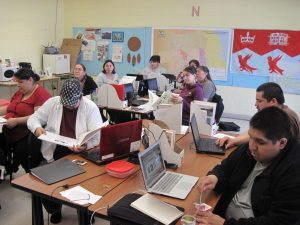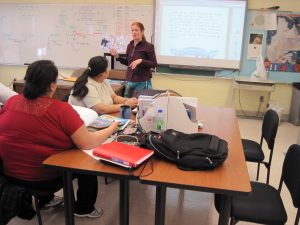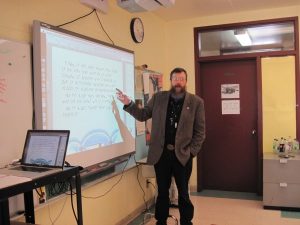For three weeks in March 2012, Bill was “guest professor” for the Naskapi III class at the Naskapi-McGill Teacher Education course. A cohort of over a dozen of the brightest Naskapi young people in Kawawachikamach are enrolled as undergrad students with McGill University under the First Nations and Inuit Education (FNIE) department.
The local Naskapi school in the community has set up a classroom that, for all intents and purposes, is part of the McGill University campus in Kawawa. Since September of 2010, these students have followed university-level courses to prepare them to serve as educators in their own community. The organizers of the program, seeing the importance of the Naskapi language in this community, have also included courses in Naskapi reading, writing and grammar, taught by Bill and with guest appearances by Norma Jean (for Naskapi children’s literature and curriculum).
This Naskapi class was held from March 13th to the 29th in 2012, in which the students studied Naskapi language structures (grammar) covering kinds of words, noun inflection, plurals, and applying grammatical features to reading. They also improved in their oral and silent reading skills of Naskapi syllabic texts, and practiced their typing of Naskapi as well.
Each of the classes that Bill has taught them also has a strong component of Naskapi culture and history, because eventually these students will be teaching Naskapi classes of their own. This class we read “A History of the Naskapis of Schefferville” by Alan Cooke, a previously unpublished manuscript that was first written in 1976, but has now been transcribed and made available in book format, now available with the other Naskapi language resources here.
Bill is pleased to report that all the students did very well and improved a great deal in their ability to read and write Naskapi. Two of his students have recently agreed to serve as “Lay Readers” in the Naskapi church, where for the past several weeks they have been reading the Naskapi scriptures during Sunday services. It is very encouraging to see the strong and growing interest in Naskapi reading and writing among adults since the publication of the Naskapi New Testament in 2007. We are anticipating some ongoing involvement in providing this kind of capacity-building training for the Naskapi community as they take more of the responsibility in maintaining and sustaining their own language.
Serving with you, Bill and Norma Jean Jancewicz.



























